java基础1(二)
Bean的xml配置
1.bean的初始化方式
三种方式: 默认构造器,静态工厂初始化(了解)和实例工厂初始化(了解)
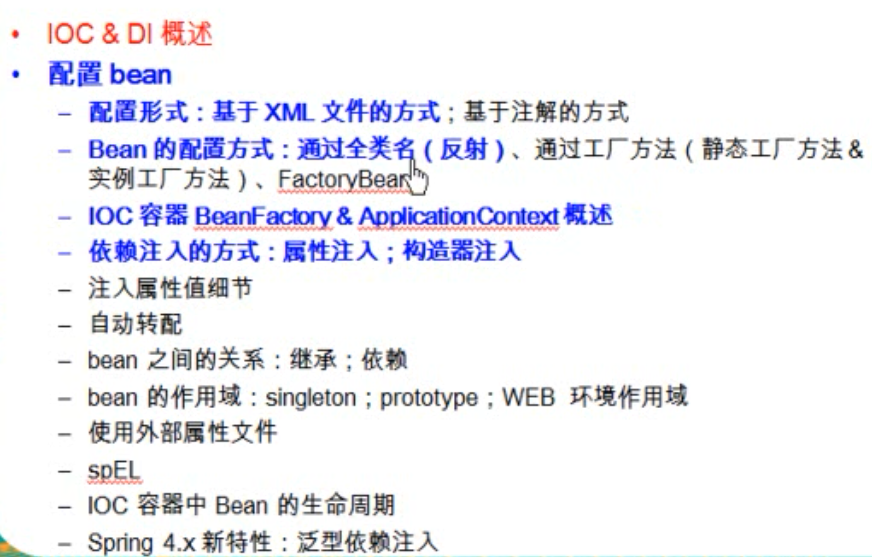
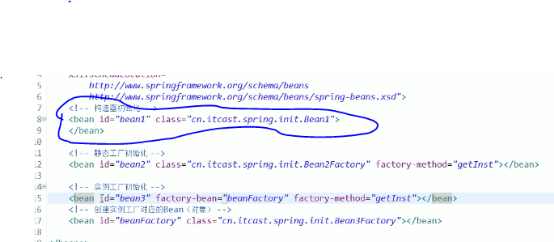
2.springbean的作用域
Bean默认作用域是单实例的
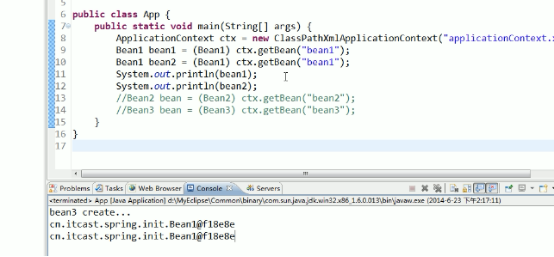
可以设置非单实例

作用域介绍:
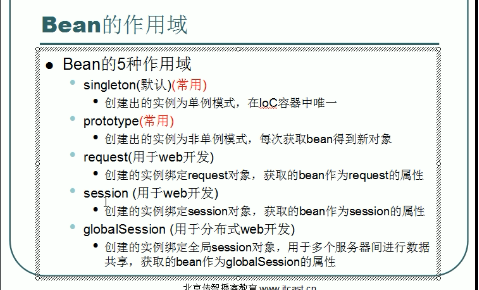
比如:将作用域设置request时,原理是在request对象创建好后调用,request.setAttribute(“bean4”,ctx.getBean(“bean4”))。

Bean的生命周期


注意: spring的bean容器关闭后才会调用销毁方法。
2.Bean的属性注入
两种方式: 构造器注入和属性注入

1) 构造器注入
配置文件

Java类

- bean的初始化使用有参数构造器时,需要同时给属性赋值,这时就叫做bean的属性注入,bean的初始化方式还是构造方法
2)setter注入
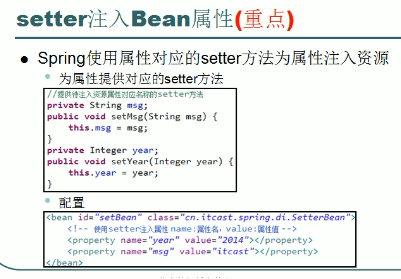
配置实例
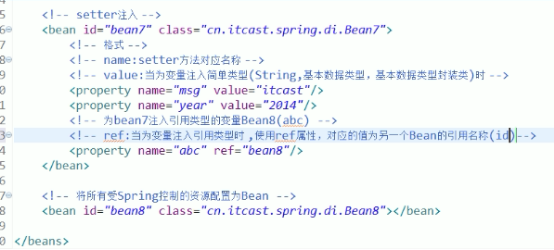
复杂属性注入
- list注入
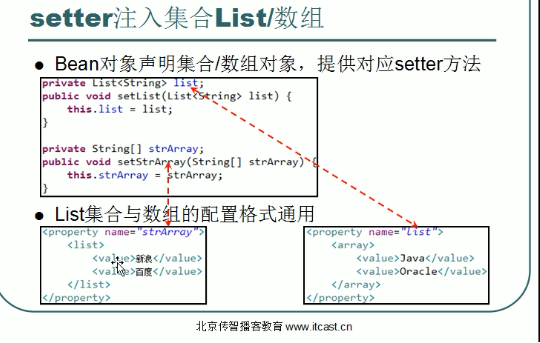
2.map属性注入
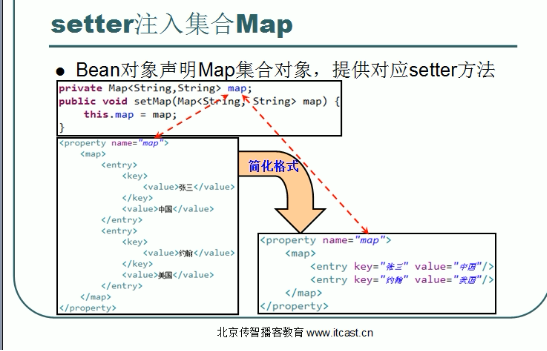
Property注入

3)团队开发

Bean的注解配置
@Autowired和qualifier(“”)注解可以使用Resource替代.

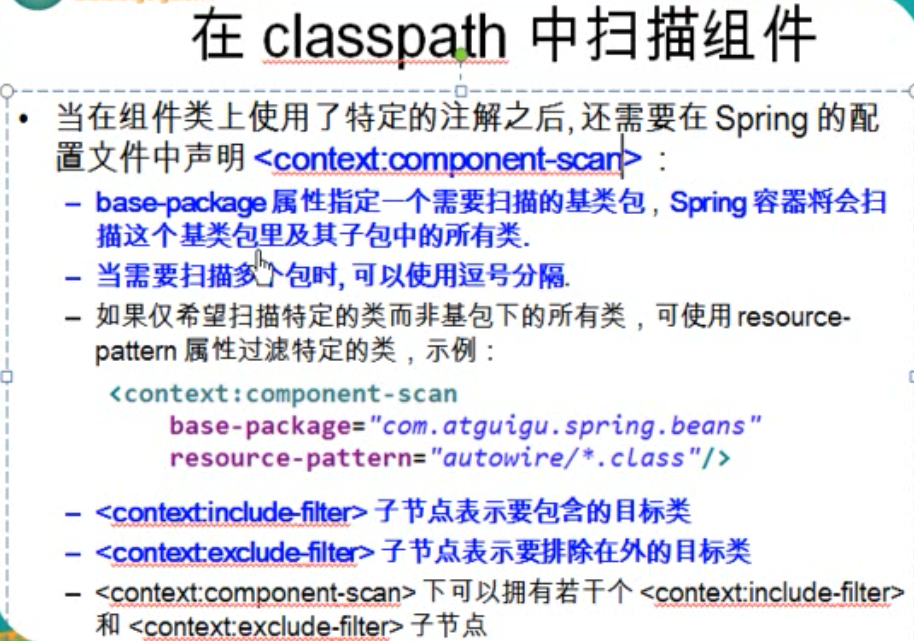
Spring整合junit
Classpath: 指定项目的根路径
@RunWith: 使用springJunit类加载器
@ContextConfiguration: 指定配置文件
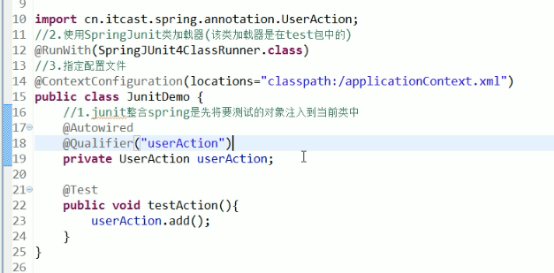
注意: @Autowired根据类型自动注入,如果类型是接口,那么会默认找到实现类.如果有多个实现类则会抱错
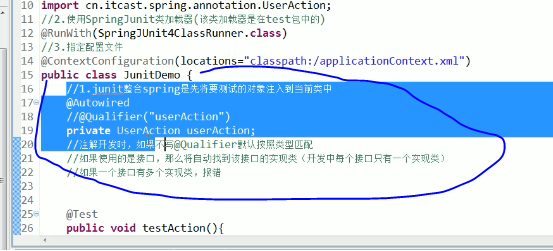
AOP
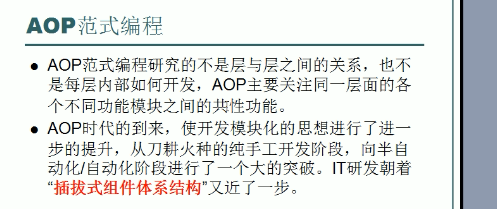
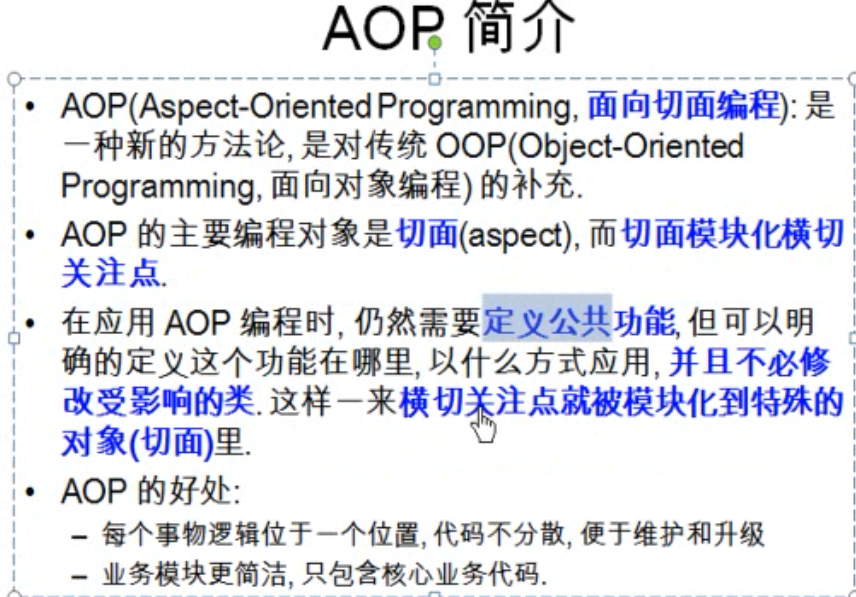

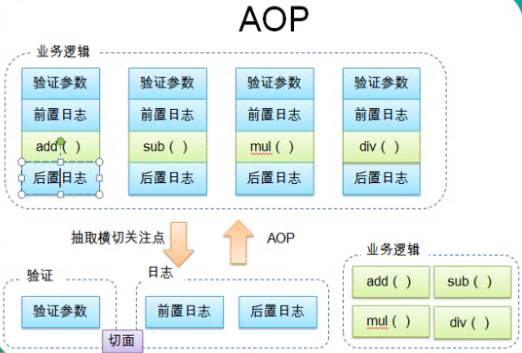
aop代码实例
1)applicationContext-aop.xml文件
<?xml version="1.0" encoding="UTF-8"?>
<beans xmlns="http://www.springframework.org/schema/beans"
xmlns:xsi="http://www.w3.org/2001/XMLSchema-instance"
xmlns:aop="http://www.springframework.org/schema/aop"
xmlns:context="http://www.springframework.org/schema/context"
xsi:schemaLocation="http://www.springframework.org/schema/beans http://www.springframework.org/schema/beans/spring-beans.xsd
http://www.springframework.org/schema/aop http://www.springframework.org/schema/aop/spring-aop-4.0.xsd
http://www.springframework.org/schema/context http://www.springframework.org/schema/context/spring-context-4.0.xsd"> <!-- 自动扫描的包 -->
<context:component-scan base-package="com.atguigu.spring.aop"></context:component-scan> <!-- 使 AspectJ 的注解起作用 -->
<aop:aspectj-autoproxy></aop:aspectj-autoproxy> </beans>
2)LoggingAspect.java类
package com.atguigu.spring.aop; import java.util.Arrays; import org.aspectj.lang.JoinPoint;
import org.aspectj.lang.annotation.After;
import org.aspectj.lang.annotation.Aspect;
import org.aspectj.lang.annotation.Before;
import org.springframework.stereotype.Component; /**
* AOP 的 helloWorld
* 1. 加入 jar 包
* com.springsource.net.sf.cglib-2.2.0.jar
* com.springsource.org.aopalliance-1.0.0.jar
* com.springsource.org.aspectj.weaver-1.6.8.RELEASE.jar
* spring-aspects-4.0.0.RELEASE.jar
*
* 2. 在 Spring 的配置文件中加入 aop 的命名空间。
*
* 3. 基于注解的方式来使用 AOP
* 3.1 在配置文件中配置自动扫描的包: <context:component-scan base-package="com.atguigu.spring.aop"></context:component-scan>
* 3.2 加入使 AspjectJ 注解起作用的配置: <aop:aspectj-autoproxy></aop:aspectj-autoproxy>
* 为匹配的类自动生成动态代理对象.
*
* 4. 编写切面类:
* 4.1 一个一般的 Java 类
* 4.2 在其中添加要额外实现的功能.
*
* 5. 配置切面
* 5.1 切面必须是 IOC 中的 bean: 实际添加了 @Component 注解
* 5.2 声明是一个切面: 添加 @Aspect
* 5.3 声明通知: 即额外加入功能对应的方法.
* 5.3.1 前置通知: @Before("execution(public int com.atguigu.spring.aop.ArithmeticCalculator.*(int, int))")
* @Before 表示在目标方法执行之前执行 @Before 标记的方法的方法体.
* @Before 里面的是切入点表达式:
*
* 6. 在通知中访问连接细节: 可以在通知方法中添加 JoinPoint 类型的参数, 从中可以访问到方法的签名和方法的参数.
*
* 7. @After 表示后置通知: 在方法执行之后执行的代码.
*/ //通过添加 @Aspect 注解声明一个 bean 是一个切面!
@Aspect
@Component
public class LoggingAspect {
//切面方法针对那些方法使用切面,@Before前置通知
@Before("execution(public int com.atguigu.spring.aop.ArithmeticCalculator.*(int, int))")
public void beforeMethod(JoinPoint joinPoint){
String methodName = joinPoint.getSignature().getName();
Object [] args = joinPoint.getArgs(); System.out.println("The method " + methodName + " begins with " + Arrays.asList(args));
} @After("execution(* com.atguigu.spring.aop.*.*(..))")
public void afterMethod(JoinPoint joinPoint){
String methodName = joinPoint.getSignature().getName();
System.out.println("The method " + methodName + " ends");
} }
3)main.java执行类
package com.atguigu.spring.aop; import org.springframework.context.ApplicationContext;
import org.springframework.context.support.ClassPathXmlApplicationContext; public class Main { public static void main(String[] args) {
// ArithmeticCalculator arithmeticCalculator = new ArithmeticCalculatorImpl();
//
// arithmeticCalculator =
// new ArithmeticCalculatorLoggingProxy(arithmeticCalculator).getLoggingProxy();
//
// int result = arithmeticCalculator.add(11, 12);
// System.out.println("result:" + result);
//
// result = arithmeticCalculator.div(21, 3);
// System.out.println("result:" + result); ApplicationContext ctx = new ClassPathXmlApplicationContext("applicationContext-aop.xml");
ArithmeticCalculator arithmeticCalculator = (ArithmeticCalculator) ctx.getBean("arithmeticCalculator"); System.out.println(arithmeticCalculator.getClass().getName()); int result = arithmeticCalculator.add(11, 12);
System.out.println("result:" + result); result = arithmeticCalculator.div(21, 3);
System.out.println("result:" + result);
} }
效果如下图:

前置通知:
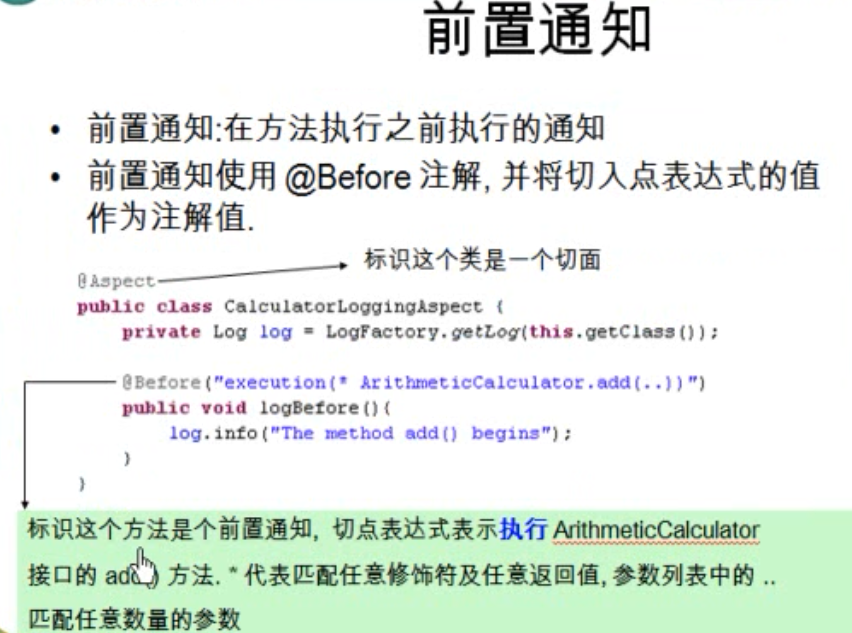
方法签名:

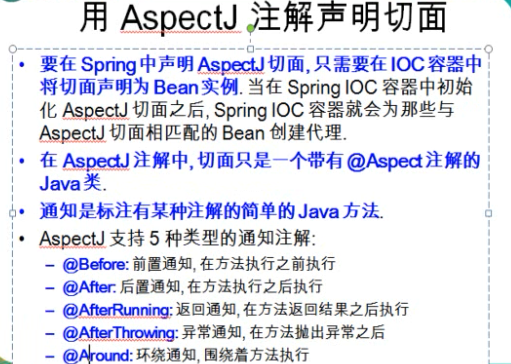
注解声明切面实例:
1.applicationContext.xml文件
<?xml version="1.0" encoding="UTF-8"?>
<beans xmlns="http://www.springframework.org/schema/beans"
xmlns:xsi="http://www.w3.org/2001/XMLSchema-instance"
xmlns:context="http://www.springframework.org/schema/context"
xmlns:aop="http://www.springframework.org/schema/aop"
xsi:schemaLocation="http://www.springframework.org/schema/aop http://www.springframework.org/schema/aop/spring-aop-4.0.xsd
http://www.springframework.org/schema/beans http://www.springframework.org/schema/beans/spring-beans.xsd
http://www.springframework.org/schema/context http://www.springframework.org/schema/context/spring-context-4.0.xsd"> <!-- 配置自动扫描的包 -->
<context:component-scan base-package="com.atguigu.spring.aop"></context:component-scan> <!-- 配置自动为匹配 aspectJ 注解的 Java 类生成代理对象 -->
<aop:aspectj-autoproxy></aop:aspectj-autoproxy> </beans>
2.定义类日志切面
package com.atguigu.spring.aop; import java.util.Arrays; import org.aspectj.lang.JoinPoint;
import org.aspectj.lang.annotation.After;
import org.aspectj.lang.annotation.AfterReturning;
import org.aspectj.lang.annotation.AfterThrowing;
import org.aspectj.lang.annotation.Aspect;
import org.aspectj.lang.annotation.Before;
import org.aspectj.lang.annotation.Pointcut;
import org.springframework.core.annotation.Order;
import org.springframework.stereotype.Component; /**
* 可以使用 @Order 注解指定切面的优先级, 值越小优先级越高
*/
@Order(2)
@Aspect
@Component
public class LoggingAspect { /**
* 定义一个方法, 用于声明切入点表达式. 一般地, 该方法中再不需要添入其他的代码.
* 使用 @Pointcut 来声明切入点表达式.
* 后面的其他通知直接使用方法名来引用当前的切入点表达式.
*/
@Pointcut("execution(public int com.atguigu.spring.aop.ArithmeticCalculator.*(..))")
public void declareJointPointExpression(){} /**
* 在 com.atguigu.spring.aop.ArithmeticCalculator 接口的每一个实现类的每一个方法开始之前执行一段代码
*/
@Before("declareJointPointExpression()")
public void beforeMethod(JoinPoint joinPoint){
String methodName = joinPoint.getSignature().getName();
Object [] args = joinPoint.getArgs(); System.out.println("The method " + methodName + " begins with " + Arrays.asList(args));
} /**
* 在方法执行之后执行的代码. 无论该方法是否出现异常
*/
@After("declareJointPointExpression()")
public void afterMethod(JoinPoint joinPoint){
String methodName = joinPoint.getSignature().getName();
System.out.println("The method " + methodName + " ends");
} /**
* 在方法法正常结束受执行的代码
* 返回通知是可以访问到方法的返回值的!
*/
@AfterReturning(value="declareJointPointExpression()",
returning="result")
public void afterReturning(JoinPoint joinPoint, Object result){
String methodName = joinPoint.getSignature().getName();
System.out.println("The method " + methodName + " ends with " + result);
} /**
* 在目标方法出现异常时会执行的代码.
* 可以访问到异常对象; 且可以指定在出现特定异常时在执行通知代码
*/
@AfterThrowing(value="declareJointPointExpression()",
throwing="e")
public void afterThrowing(JoinPoint joinPoint, Exception e){
String methodName = joinPoint.getSignature().getName();
System.out.println("The method " + methodName + " occurs excetion:" + e);
} /**
* 环绕通知需要携带 ProceedingJoinPoint 类型的参数.
* 环绕通知类似于动态代理的全过程: ProceedingJoinPoint 类型的参数可以决定是否执行目标方法.
* 且环绕通知必须有返回值, 返回值即为目标方法的返回值
*/
/*
@Around("execution(public int com.atguigu.spring.aop.ArithmeticCalculator.*(..))")
public Object aroundMethod(ProceedingJoinPoint pjd){ Object result = null;
String methodName = pjd.getSignature().getName(); try {
//前置通知
System.out.println("The method " + methodName + " begins with " + Arrays.asList(pjd.getArgs()));
//执行目标方法
result = pjd.proceed();
//返回通知
System.out.println("The method " + methodName + " ends with " + result);
} catch (Throwable e) {
//异常通知
System.out.println("The method " + methodName + " occurs exception:" + e);
throw new RuntimeException(e);
}
//后置通知
System.out.println("The method " + methodName + " ends"); return result;
}
*/
}
3.定义校验切面
package com.atguigu.spring.aop; import java.util.Arrays; import org.aspectj.lang.JoinPoint;
import org.aspectj.lang.annotation.Aspect;
import org.aspectj.lang.annotation.Before;
import org.springframework.core.annotation.Order;
import org.springframework.stereotype.Component; @Order(1)
@Aspect
@Component
public class VlidationAspect { @Before("com.atguigu.spring.aop.LoggingAspect.declareJointPointExpression()")
public void validateArgs(JoinPoint joinPoint){
System.out.println("-->validate:" + Arrays.asList(joinPoint.getArgs()));
} }
4.arithmeticCalculator类
package com.atguigu.spring.aop;
import org.springframework.stereotype.Component;
@Component("arithmeticCalculator")
public class ArithmeticCalculatorImpl implements ArithmeticCalculator {
@Override
public int add(int i, int j) {
int result = i + j;
return result;
}
@Override
public int sub(int i, int j) {
int result = i - j;
return result;
}
@Override
public int mul(int i, int j) {
int result = i * j;
return result;
}
@Override
public int div(int i, int j) {
int result = i / j;
return result;
}
}
5.Main.java类
package com.atguigu.spring.aop; import org.springframework.context.ApplicationContext;
import org.springframework.context.support.ClassPathXmlApplicationContext; public class Main { public static void main(String[] args) { ApplicationContext ctx = new ClassPathXmlApplicationContext("applicationContext.xml");
ArithmeticCalculator arithmeticCalculator = (ArithmeticCalculator) ctx.getBean("arithmeticCalculator"); System.out.println(arithmeticCalculator.getClass().getName()); int result = arithmeticCalculator.add(1, 2);
System.out.println("result:" + result); result = arithmeticCalculator.div(1000, 10);
System.out.println("result:" + result);
} }
方法执行截图:
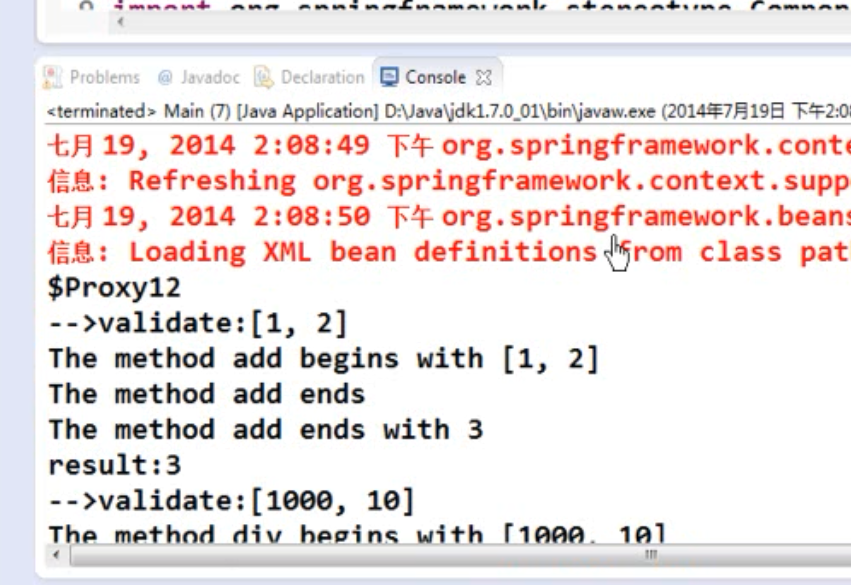
spring声明式事务
xml文件:
<?xml version="1.0" encoding="UTF-8"?>
<beans xmlns="http://www.springframework.org/schema/beans"
xmlns:xsi="http://www.w3.org/2001/XMLSchema-instance"
xmlns:context="http://www.springframework.org/schema/context"
xmlns:tx="http://www.springframework.org/schema/tx"
xsi:schemaLocation="http://www.springframework.org/schema/beans http://www.springframework.org/schema/beans/spring-beans.xsd
http://www.springframework.org/schema/tx http://www.springframework.org/schema/tx/spring-tx-4.0.xsd
http://www.springframework.org/schema/context http://www.springframework.org/schema/context/spring-context-4.0.xsd"> <context:component-scan base-package="com.atguigu.spring"></context:component-scan> <!-- 导入资源文件 -->
<context:property-placeholder location="classpath:db.properties"/> <!-- 配置 C3P0 数据源 -->
<bean id="dataSource"
class="com.mchange.v2.c3p0.ComboPooledDataSource">
<property name="user" value="${jdbc.user}"></property>
<property name="password" value="${jdbc.password}"></property>
<property name="jdbcUrl" value="${jdbc.jdbcUrl}"></property>
<property name="driverClass" value="${jdbc.driverClass}"></property> <property name="initialPoolSize" value="${jdbc.initPoolSize}"></property>
<property name="maxPoolSize" value="${jdbc.maxPoolSize}"></property>
</bean> <!-- 配置 Spirng 的 JdbcTemplate -->
<bean id="jdbcTemplate"
class="org.springframework.jdbc.core.JdbcTemplate">
<property name="dataSource" ref="dataSource"></property>
</bean> <!-- 配置 NamedParameterJdbcTemplate, 该对象可以使用具名参数, 其没有无参数的构造器, 所以必须为其构造器指定参数 -->
<bean id="namedParameterJdbcTemplate"
class="org.springframework.jdbc.core.namedparam.NamedParameterJdbcTemplate">
<constructor-arg ref="dataSource"></constructor-arg>
</bean> <!-- 配置事务管理器 -->
<bean id="transactionManager"
class="org.springframework.jdbc.datasource.DataSourceTransactionManager">
<property name="dataSource" ref="dataSource"></property>
</bean> <!-- 启用事务注解 -->
<tx:annotation-driven transaction-manager="transactionManager"/> </beans>
代码如下:
package com.atguigu.spring.tx; import org.springframework.beans.factory.annotation.Autowired;
import org.springframework.stereotype.Service;
import org.springframework.transaction.annotation.Isolation;
import org.springframework.transaction.annotation.Propagation;
import org.springframework.transaction.annotation.Transactional; @Service("bookShopService")
public class BookShopServiceImpl implements BookShopService { @Autowired
private BookShopDao bookShopDao; //添加事务注解
//1.使用 propagation 指定事务的传播行为, 即当前的事务方法被另外一个事务方法调用时
//如何使用事务, 默认取值为 REQUIRED, 即使用调用方法的事务
//REQUIRES_NEW: 事务自己的事务, 调用的事务方法的事务被挂起.
//2.使用 isolation 指定事务的隔离级别, 最常用的取值为 READ_COMMITTED
//3.默认情况下 Spring 的声明式事务对所有的运行时异常进行回滚. 也可以通过对应的
//属性进行设置. 通常情况下去默认值即可.
//4.使用 readOnly 指定事务是否为只读. 表示这个事务只读取数据但不更新数据,
//这样可以帮助数据库引擎优化事务. 若真的事一个只读取数据库值的方法, 应设置 readOnly=true
//5.使用 timeout 指定强制回滚之前事务可以占用的时间.
// @Transactional(propagation=Propagation.REQUIRES_NEW,
// isolation=Isolation.READ_COMMITTED,
// noRollbackFor={UserAccountException.class})
@Transactional(propagation=Propagation.REQUIRES_NEW,
isolation=Isolation.READ_COMMITTED,
readOnly=false,
timeout=3)
@Override
public void purchase(String username, String isbn) { try {
Thread.sleep(5000);
} catch (InterruptedException e) {} //1. 获取书的单价
int price = bookShopDao.findBookPriceByIsbn(isbn); //2. 更新数的库存
bookShopDao.updateBookStock(isbn); //3. 更新用户余额
bookShopDao.updateUserAccount(username, price);
} }
事务传播行为
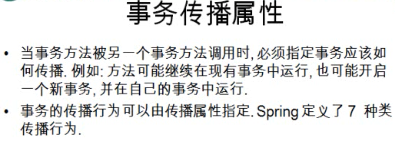

在web中应该怎么使用spring
1.思路整理
1. Spring 如何在 WEB 应用中使用 ? 1). 需要额外加入的 jar 包: spring-web-4.0.0.RELEASE.jar
spring-webmvc-4.0.0.RELEASE.jar 2). Spring 的配置文件, 没有什么不同 3). 如何创建 IOC 容器 ? ①. 非 WEB 应用在 main 方法中直接创建
②. 应该在 WEB 应用被服务器加载时就创建 IOC 容器: 在 ServletContextListener#contextInitialized(ServletContextEvent sce) 方法中创建 IOC 容器. ③. 在 WEB 应用的其他组件中如何来访问 IOC 容器呢 ? 在 ServletContextListener#contextInitialized(ServletContextEvent sce) 方法中创建 IOC 容器后, 可以把其放在
ServletContext(即 application 域)的一个属性中. ④. 实际上, Spring 配置文件的名字和位置应该也是可配置的! 将其配置到当前 WEB 应用的初始化参数中较为合适. 2. Spring 如何整合 Struts2 ?
2.web.xml配置
<?xml version="1.0" encoding="UTF-8"?>
<web-app xmlns:xsi="http://www.w3.org/2001/XMLSchema-instance" xmlns="http://java.sun.com/xml/ns/javaee" xsi:schemaLocation="http://java.sun.com/xml/ns/javaee http://java.sun.com/xml/ns/javaee/web-app_2_5.xsd" id="WebApp_ID" version="2.5">
<!--配置servletContext的初始化参数-->
<context-param>
<param-name>configLocation</param-name>
<param-value>applicationContext.xml</param-value>
</context-param> <!--配置servletContext监听器,用于初始化ioc容器-->
<listener>
<listener-class>com.atguigu.spring.struts2.listeners.SpringServletContextListener</listener-class>
</listener>
<!--配置servletContext-->
<servlet>
<description></description>
<display-name>TestServlet</display-name>
<servlet-name>TestServlet</servlet-name>
<servlet-class>com.atguigu.spring.struts2.servlets.TestServlet</servlet-class>
</servlet>
<servlet-mapping>
<servlet-name>TestServlet</servlet-name>
<url-pattern>/TestServlet</url-pattern>
</servlet-mapping>
</web-app>
3.SpringServletContextListener
package com.atguigu.spring.struts2.listeners; import javax.servlet.ServletContext;
import javax.servlet.ServletContextEvent;
import javax.servlet.ServletContextListener; import org.springframework.context.ApplicationContext;
import org.springframework.context.support.ClassPathXmlApplicationContext; /**
* Application Lifecycle Listener implementation class SpringServletContextListener
*
*/
public class SpringServletContextListener implements ServletContextListener { /**
* Default constructor.
*/
public SpringServletContextListener() {
// TODO Auto-generated constructor stub
} /**
* @see ServletContextListener#contextInitialized(ServletContextEvent)
*/
public void contextInitialized(ServletContextEvent arg0) {
//1. 获取 Spring 配置文件的名称.
ServletContext servletContext = arg0.getServletContext();
String config = servletContext.getInitParameter("configLocation"); //1. 创建 IOC 容器
ApplicationContext ctx = new ClassPathXmlApplicationContext(config); //2. 把 IOC 容器放在 ServletContext 的一个属性中.
servletContext.setAttribute("ApplicationContext", ctx);
} /**
* @see ServletContextListener#contextDestroyed(ServletContextEvent)
*/
public void contextDestroyed(ServletContextEvent arg0) {
// TODO Auto-generated method stub
} }
4.applicationContext.xml
<?xml version="1.0" encoding="UTF-8"?>
<beans xmlns="http://www.springframework.org/schema/beans"
xmlns:xsi="http://www.w3.org/2001/XMLSchema-instance"
xsi:schemaLocation="http://www.springframework.org/schema/beans http://www.springframework.org/schema/beans/spring-beans.xsd"> <bean id="person"
class="com.atguigu.spring.struts2.beans.Person">
<property name="username" value="atguigu"></property>
</bean> </beans>
5.testservelt.java ---测试类
package com.atguigu.spring.struts2.servlets; import java.io.IOException; import javax.servlet.ServletContext;
import javax.servlet.ServletException;
import javax.servlet.http.HttpServlet;
import javax.servlet.http.HttpServletRequest;
import javax.servlet.http.HttpServletResponse; import org.springframework.context.ApplicationContext; import com.atguigu.spring.struts2.beans.Person; /**
* Servlet implementation class TestServlet
*/
public class TestServlet extends HttpServlet {
private static final long serialVersionUID = 1L; /**
* @see HttpServlet#doGet(HttpServletRequest request, HttpServletResponse response)
*/
protected void doGet(HttpServletRequest request, HttpServletResponse response) throws ServletException, IOException {
//1. 从 application 域对象中得到 IOC 容器的引用
ServletContext servletContext = getServletContext();
ApplicationContext ctx = (ApplicationContext) servletContext.getAttribute("ApplicationContext"); //2. 从 IOC 容器中得到需要的 bean
Person person = ctx.getBean(Person.class);
person.hello();
} }
在web中使用spring
4). 在 WEB 环境下使用 Spring ①. 需要额外加入的 jar 包: spring-web-4.0.0.RELEASE.jar
spring-webmvc-4.0.0.RELEASE.jar ②. Spring 的配置文件, 和非 WEB 环境没有什么不同 ③. 需要在 web.xml 文件中加入如下配置: <!-- 配置 Spring 配置文件的名称和位置 -->
<context-param>
<param-name>contextConfigLocation</param-name>
<param-value>classpath:applicationContext.xml</param-value>
</context-param> <!-- 启动 IOC 容器的 ServletContextListener -->
<listener>
<listener-class>org.springframework.web.context.ContextLoaderListener</listener-class>
</listener>
web.xml文件
<?xml version="1.0" encoding="UTF-8"?>
<web-app xmlns:xsi="http://www.w3.org/2001/XMLSchema-instance" xmlns="http://java.sun.com/xml/ns/javaee" xsi:schemaLocation="http://java.sun.com/xml/ns/javaee http://java.sun.com/xml/ns/javaee/web-app_2_5.xsd" id="WebApp_ID" version="2.5"> <!-- 配置 Spring 配置文件的名称和位置 -->
<context-param>
<param-name>contextConfigLocation</param-name>
<param-value>classpath:applicationContext.xml</param-value>
</context-param> <!-- 启动 IOC 容器的 ServletContextListener -->
<listener>
<listener-class>org.springframework.web.context.ContextLoaderListener</listener-class>
</listener> <!-- 配置 Struts2 的 Filter -->
<filter>
<filter-name>struts2</filter-name>
<filter-class>org.apache.struts2.dispatcher.ng.filter.StrutsPrepareAndExecuteFilter</filter-class>
</filter> <filter-mapping>
<filter-name>struts2</filter-name>
<url-pattern>/*</url-pattern>
</filter-mapping> </web-app>
Xml文件操作
Schema约束
w3c中http://www.w3.org/2001/XMLSchema-instance,这个是w3预定义的命名空间。客户可以根据这个名称空间创建自己的约束文档。就像w3定义了一个标准接口一样,实现这个接口可以具备自定义约束文档的能力,比如:<complexType>这个标签就是w3预定义的标签,用于客户实现自己的约束文档。用户做完自己的约束文档后就可以在实例文档中使用这个约束文档,创建对应的配置文件。
即定义自己的约束文档然后使用的过程是:
自定义约束文档: 引入w3预定义命名空间,使用其内的标签定义自己的约束标签。
实例文档: 引入预定义命名空间,引入自定义明明空间和位置。使用自定义标签进行配置,从而完成配置文件作用。

使用实例:
如下:
1)xmls引入自定义命名空间 2)xmlns:xsi:引入预定义命名空间 3)xsi:schemalocation:引入自定义空间位置
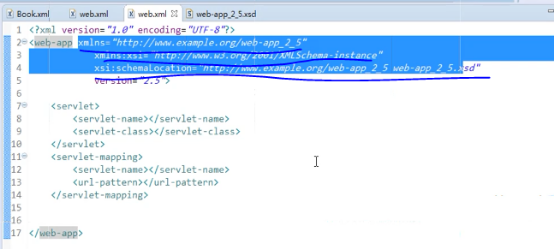
Xml解析


java基础1(二)的更多相关文章
- java 基础知识二 基本类型与运算符
java 基础知识二 基本类型与运算符 1.标识符 定义:为类.方法.变量起的名称 由大小写字母.数字.下划线(_)和美元符号($)组成,同时不能以数字开头 2.关键字 java语言保留特殊含义或者 ...
- java基础(二章)
java基础(二章) 一,变量 1.变量是内存中的一个标识符号,用于存储数据 2.变量命名规则 l 必须以字母.下划线 _ .美元符号 $ 开头 l 变量中,可以包括数字 l 变量中,不能出现特 ...
- Java基础十二--多态是成员的特点
Java基础十二--多态是成员的特点 一.特点 1,成员变量. 编译和运行都参考等号的左边. 覆盖只发生在函数上,和变量没关系. Fu f = new Zi();System.out.println( ...
- java基础-多线程二
java基础-多线程二 继承thread和实现Runnable的多线程每次都需要经历创建和销毁的过程,频繁的创建和销毁大大影响效率,线程池的诞生就可以很好的解决这一个问题,线程池可以充分的利用线程进行 ...
- JAVA基础(二)—— 常用的类与方法
JAVA基础(二)-- 常用的类与方法 1 Math类 abs ceil floor 绝对值 大于等于该浮点数的最小整数 小于等于该浮点数的最大整数 max min round 两参数中较大的 两参数 ...
- Java实习生常规技术面试题每日十题Java基础(二)
目录 1. JAVA 的反射机制的原理. 2.静态嵌套类(Static Nested Class)和内部类(Inner Class)的不同? 3.如何将String类型转化成Number类型. 4.什 ...
- Java基础系列二:Java泛型
该系列博文会告诉你如何从入门到进阶,一步步地学习Java基础知识,并上手进行实战,接着了解每个Java知识点背后的实现原理,更完整地了解整个Java技术体系,形成自己的知识框架. 一.泛型概述 1.定 ...
- Java 基础(二)| 使用 lambad 表达式的正确姿势
前言 为跳槽面试做准备,今天开始进入 Java 基础的复习.希望基础不好的同学看完这篇文章,能掌握 lambda 表达式,而基础好的同学权当复习,希望看完这篇文章能够起一点你的青涩记忆. 一.什么是 ...
- Java基础(十二)--clone()方法
Clone在Java中就是用来复制对象,通过分配一个和源对象相同大小的内存空间,然后创建一个新的对象,那么他和=的区别在哪? 通过=实现对象拷贝: @Data @NoArgsConstructor @ ...
- Java基础教程——二维数组
二维数组 Java里的二维数组其实是数组的数组,即每个数组元素都是一个数组. 每个数组的长度不要求一致,但最好一致. // 同样有两种风格的定义方法 int[][] _arr21_推荐 = { { 1 ...
随机推荐
- 【Java基础】浅谈常见设计模式
Num1:单例模式 基本概念:保证一个类仅有一个实例,并提供一个访问它的全局访问点. 常见写法: 懒汉式 public class Singleton { /* 持有私有静态实例,防止被引用,此处赋值 ...
- Django 中使用 Celery
起步 在 <分布式任务队列Celery使用说明> 中介绍了在 Python 中使用 Celery 来实验异步任务和定时任务功能.本文介绍如何在 Django 中使用 Celery. 安装 ...
- JavaScript代码压缩工具UglifyJS和Google Closure Compiler的基本用法
网上搜索了,目前主流的Js代码压缩工具主要有Uglify.YUI Compressor.Google Closure Compiler,简单试用了UglifyJS 和Google Closure Co ...
- 2019 年 Spread.NET 产品路线图(Roadmap)
前言 | 问题背景 2018年结束了,12月是Spread.NET的重要月份.我们发布了Spread.NET 12,我们期待着 2019 年令人兴奋的新年,这是Windows Forms开发人员有史以 ...
- webpack学习笔记 (二) html-webpack-plugin使用
这个插件的两个作用: 为html文件中引入的外部资源如script.link动态添加每次compile后的hash,防止引用缓存的外部文件问题 可以生成创建html入口文件,比如单页面可以生成一个ht ...
- Shopping List
剃须啫喱 吉列 70g $22.00 鲁阳家居专营店 剃须水套装 阿帕奇+酷曼 230g+230g $16.80(限时活动) 鲁阳家居专营店 鸡胸肉 撸铁党 100gx9+100g $49.9(限时活 ...
- QTL定位相关
1.原理 https://www.sohu.com/a/211301179_278730 较为详细
- 亚马逊促销活动Promotion②:Money Off(满减折扣)的设置教程
满减.折扣是放之四海皆有效的促销手段,虽然亚马逊对卖家有诸多限制,但这个促销方式却是允许的,对亚马逊的卖家而言,这对提升商品销量.打造爆款都是极好的.今天小编来讲讲亚马逊的Money Off要怎么设置 ...
- Python 进度条原理
#进度条原理 import sys,time for i in range(50): sys.stdout.write("#")#标准输出 #若不能够按照时间一个一个依次显示,则代 ...
- RESTful协议
目的:在符合架构原理的前提下,理解和评估以网络为基础的应用软件的架构设计,得到一个功能强.性能好.适宜通信的架构 解决问题:如何开发在互联网环境中使用的软件,实现网站即软件 涉及主要元素 资源(Res ...
